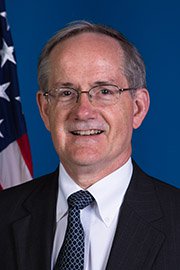Wednesday at AUVSI’s Xponential conference in Chicago kicked off with another keynote address – this one carrying the theme of “The Power of Execution.” In addition to David Albritton, President of General Motors Defence LLC; and Mike Fields of insurance giant State Farm, the morning introduced Carl Burleson, the second highest ranking official at the FAA.
After thanking former FAA Administrator Michael Huerta for “setting the stage” for the work that the FAA is doing in the drone industry, Burleson pointed out that 1.4 million drones have been registered and more than 130,000 Part 107 certifications issued – which means, says Burleson, “There are nearly 4 times as many UAS than manned aircraft in the NAS.”
That this has caused a challenge for the agency is not news. As the commercial drone industry pushes for flexible regulation, the essential tension between a need for speed and the FAA’s timeline of safety has led to a sometimes uneasy truce between the two, with both parties recognizing that collaboration is the only way to achieve both goals.
This morning, Burleson said that what the FAA really needs to move forward on integration is more data. “That’s why the UAS IPP [Integration Pilot Program] was so important,” said Burleson. “This is allowing us… to develop regulations through practical applications and collecting data.”
“We really see this as a win-win,” Burleson continued, mentioning some of the IPP programs which have recently moved from proof of concept to continued operations. “They are proving… how small UAS are beneficial,” he said. “…The IPP is already paying dividends on this investment.”
Burleson said that the agency is “working hard to respond” to the more than 1,000 comments received on recent legislation proposals, and says that the FAA hopes to “gradually expand” the way that operations like flight over people and beyond visual line of sight (BVLOS) happen.
In addition, however, Burleson says that Remote ID must be a first step towards further integration of drones into the National Airspace (NAS.)
“We understand that remote identification is fundamental,” says Burleson, commenting that the ability to connect a drone with its operator is a basic foundation of airspace security.
Finally, Burleson commented on the need for an improved technology infrastructure, “Given the expected volumes,” says Burleson, “..drone traffic management must be automated.” The Low Altitude Authorization and Notification Capability (LAANC) has been a successful first step in this direction, says Burleson, but there is more to do. “Since [LAANC] program launch we have received 90,000 authorization requests – almost 90% of which were approved,” he says. “LAANC is an important step – but just the first step.”
Burleson closed by stating that the agency recognizes that drone integration is crucial. “Small drones are already changing the landscape of our society,” Burleson said. “We at the FAA recognize that we have hit the age of innovation…. the FAA is excited about it.”
Miriam McNabb is the Editor-in-Chief of DRONELIFE and CEO of JobForDrones, a professional drone services marketplace, and a fascinated observer of the emerging drone industry and the regulatory environment for drones. Miriam has a degree from the University of Chicago and over 20 years of experience in high tech sales and marketing for new technologies.
Email Miriam
TWITTER:@spaldingbarker
Subscribe to DroneLife here.
https://dronelife.com/2019/05/01/faa-acting-deputy-administrator-carl-burleson-our-job-is-to-find-a-way-forward/
 Unmanned Aerial Vehicle The latest drone news
Unmanned Aerial Vehicle The latest drone news






